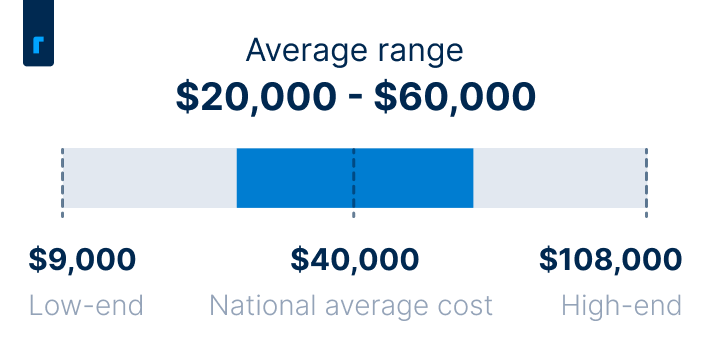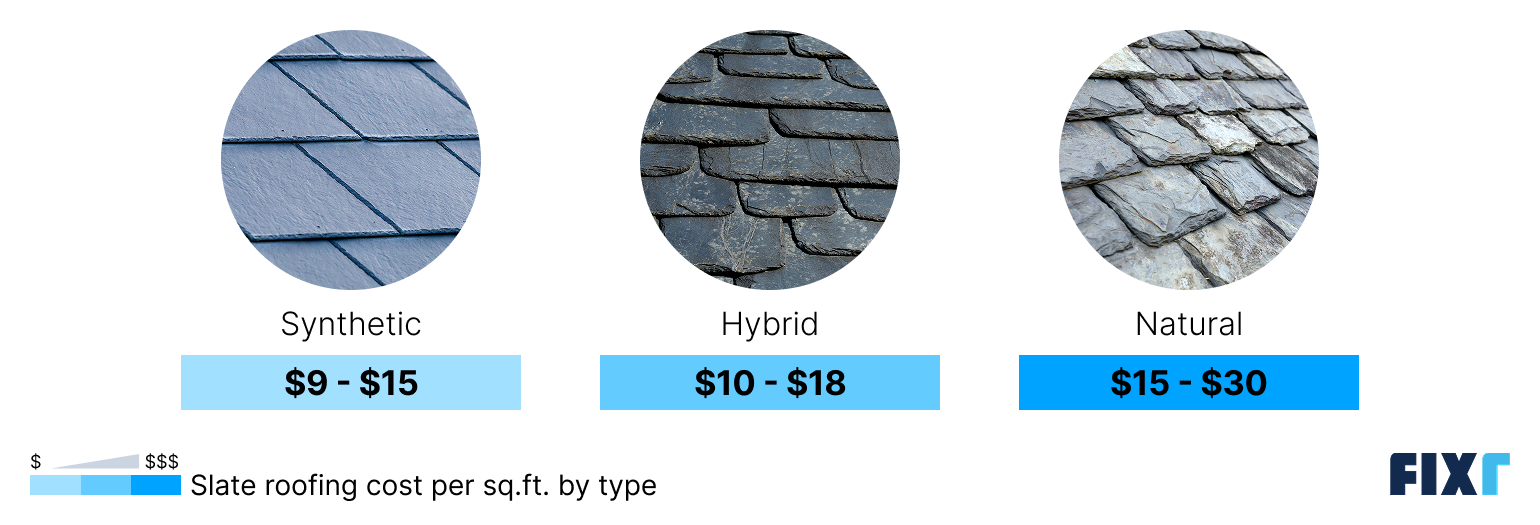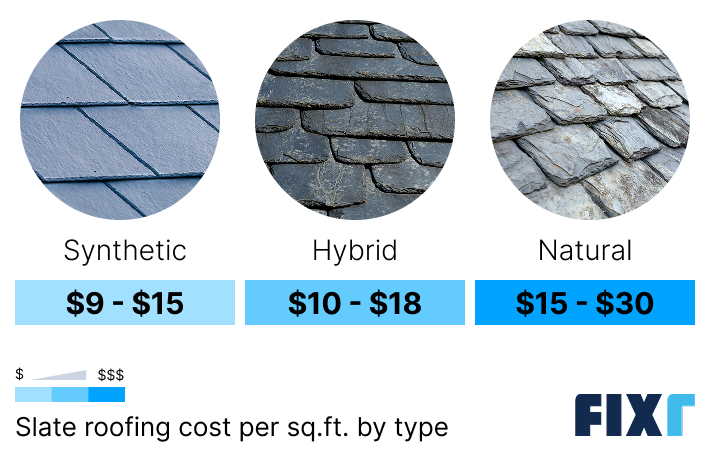Updated: November 27, 2025
Written by Dan Simms
Nieves is a home remodeling editor at Fixr.com with special interest in landscaping, pest control, painting, installation, and repair projects. She brings her work ethic, creativity, and love for teamwork into everything she does, including working with writers and designers at Fixr.com to develop useful and comprehensive guides for homeowners.
Learn moreReviewed by Nieves Martinez
Slate may not be the most popular roofing material due to its upfront cost, but it is the most durable and longest-lasting option. With a lifespan of up to 200 years and a high resistance to leaks and physical damage, it’s popular among homeowners looking for the greatest value possible. Not only can slate outlast any other roofing material, but it also maximizes curb appeal and provides a greater bump to your home value than other options.
The average cost to install a slate roof is $40,000, and most homeowners pay somewhere between $20,000 and $60,000. Your slate roof price will depend mostly on your home size, roof design, whether you choose natural or synthetic slate, your proximity to a natural source of slate, and local labor costs.
Cost of Slate Roof


Slate Roof Cost by Type
There are three types of slate to choose from when installing a slate roof. Natural slate is a material that’s mined in quarries, so your proximity to a natural source and the supply available can dramatically affect costs. Synthetic slate is a composite material made from plastic, metal, asphalt, and other materials. Hybrid products are made using real stone coupled with waterproofing materials.
The type of slate roof you choose will affect your total costs and the look of your roof, as well as the durability and lifespan.


Type | Cost Range Per Square Foot |
Synthetic | $9 – $15 |
Hybrid | $10 – $18 |
Natural | $15 – $30 |
Synthetic Slate Roof Cost
Synthetic slate doesn’t actually contain real slate. Instead, it’s made with plastics, metals, and other materials that are manufactured to resemble the color and texture of real slate. It is the most affordable, averaging between $9 and $15 per square foot, but it’s also the least durable, as it lasts for around 50 years.
Other slate alternatives, such as rubber, clay, or metal roofing, are also made to mimic slate. Rubber options can cost as little as $4 per square foot. Keep in mind that none of these alternatives will perfectly match the look or durability of real slate.
Hybrid Slate Roof Cost
Hybrid slate is a mixture of real slate and other materials, so it’s a midway point between synthetic and natural slate. It costs between $10 and $18 per square foot, so it’s generally more expensive than synthetic, mostly because it still includes real slate, which increases the cost of sourcing and production. The natural stone also increases its durability, giving a hybrid roof a lifespan of 75 to 100 years or more.
Natural Slate Roof Cost
Natural slate is made entirely of stone from quarries. Its limited availability and heavy weight drive up costs for both the material and specialized installation. Natural slate roofing costs can climb as high as $30 per square foot, but the material lasts longer than any other roofing option, with a lifespan of up to 200 years.
There are two subtypes within the natural category: soft and hard slate. Soft slate is less dense and less durable, typically costing $15 to $20 per square foot. Hard slate is more dense, highly water-resistant, and can withstand more stress, making it the longer-lasting and more durable option at $20 to $30 per square foot.
Slate Roof Cost per Square Foot
The average cost of a new slate roof per square foot is $20, but that price can range from $9 up to $30 per square foot, including materials and labor. The cost per square foot depends on the type of slate roof you choose, but also on the complexity of your roof design and how readily accessible materials are in your area.
The largest cost factor is the size of your project, as most quotes are based on the square footage of materials required and the labor needed for installation. You can use the table below to get an idea of your total based on your home size.
Home Size (Square Feet) | Average Roof Square Footage | Typical Cost Range |
800 | 1,000 | $9,000 – $30,000 |
1,000 | 1,200 | $10,800 – $36,000 |
1,500 | 1,800 | $16,200 – $54,000 |
1,700 | 2,000 | $18,000 – $60,000 |
2,000 | 2,400 | $21,600 – $72,000 |
2,500 | 3,000 | $27,000 – $90,000 |
3,000 | 3,600 | $32,400 – $108,000 |
Slate Roof Replacement Cost Factors
The type of slate roof you decide on and the size of your home are, by far, the two most crucial factors that determine your slate roof costs. However, many other factors can affect your total, so it’s important to consider them all to get an accurate estimate for your roofing project.
Roof Complexity and Pitch
The shape and slope of your roof greatly affect installation time and labor costs. Simple, low-slope roofs are easier and less expensive to re-roof, while steep roofs or those with multiple hips, valleys, ridges, or dormers require extra safety measures and more time, which can increase the overall cost, especially for slate.
Local Labor Costs
Labor for slate roof installation can vary widely depending on your location, with higher costs in areas where the cost of living is higher. Labor typically makes up 40 to 60% of the total slate roof cost, due to the specialized skills required to handle fragile, heavy slate tiles safely. Roofers must carefully place each tile to avoid cracks or damage, which takes more time than installing asphalt or metal roofs.
Structural Reinforcement
Slate is one of the heaviest roofing materials, typically weighing between 1,000 and 2,000 pounds per square (100 square feet). If you’ve never had a slate roof before, you should call in a structural engineer to ensure your home can support the added weight. In many cases, especially with older homes, you’ll need to budget for additional structural reinforcements, which can add between $1,000 and $10,000 to your total.
Old Roof Removal and Disposal
Most roofers will include the cost of removing your old roof and hauling away the debris in their initial estimates. If yours doesn’t, you’ll need to budget for this separately. This could add between $50 and $150 per square to your total.
Unexpected Damage
There’s always a risk during roof removal that your professional will uncover hidden damage to your roof decking, rafters, or other materials below. It’s a good idea to budget an additional $150 to $1,000 for repairs, especially if you’re replacing your roof because of roof leaks or other problems.
Geographic Location
Your location influences both local labor costs and the price of materials, especially natural slate. Since natural slate is mined in quarries, proximity to a source is key. For example, the “slate belt” in the U.S. is located in Pennsylvania, so slate roof tile costs are significantly lower in the Northeast than they are on the West Coast, where long shipping and delivery timelines drive up material costs.
Additional Materials
Roof replacement includes new flashing and underlayment. Since slate lasts up to 200 years, you should invest in durable materials underneath. Upgrading to a high-end synthetic underlayment and long-lasting flashing, like copper, adds to the upfront cost but prevents you from having to remove your roof to replace the materials underneath.
Ongoing Maintenance
Budget for routine maintenance to protect your investment. Plan for an annual roof inspection, which typically costs around $250. Slate roof cleaning costs between $600 and $1,000, depending on the roof size, and can be done as needed or once every two to five years.
Slate Roof Replacement vs. Repair
Since replacing a slate roof is so expensive, and since the material itself has such a long lifespan, one of the first things you should do when you’re considering a replacement is to decide if a repair would be a better financial decision. Slate roof repairs cost between $300 and $1,600, depending on the extent of the damage, so repairs will almost always be more affordable than a full replacement, which averages $40,000.
However, there are some situations in which a replacement is a better financial option in the long run:
Ongoing leaks: A single leak is usually easy to fix, but repeated leaks may signal it’s time for a full replacement to avoid frequent repairs and rising costs.
Curb appeal: If your slate roof is old and worn, a replacement can boost your home’s appearance. It might be an especially good option if you plan to sell.
Roof lifespan: If your slate roof is over 100 years old and showing issues like leaks or poor energy efficiency, a replacement provides long-term reliability and peace of mind.
High repair costs: Slate is generally easy to repair, but if repairs approach 50% or more of a new roof’s cost, a full replacement may be the smarter choice.
Pros and Cons of Slate Roofing
Since a slate roof is a big investment, you should understand all of the pros and cons of slate roofing before you decide if it’s the right one for your home.
Pros
- + Extremely long lifespan (up to 200 years)
- + Very durable in extreme weather
- + Easy to repair (individual tiles)
- + High curb appeal and home value
- + Naturally energy-efficient
- + Fire-resistant
- + More eco-friendly than many manufactured materials
Cons
- - Very high upfront cost
- - Very heavy (may need structural reinforcement)
- - Can crack under foot traffic or impact
- - Some types absorb water in heavy-rain areas
Alternatives to Slate Roofing
While slate is a beautiful and long-lasting option, it’s not the only choice for your roof. If you’re concerned about the cost, exploring alternative roofing materials can help you find a solution that fits your budget and style. The table below offers a quick comparison to guide your decision.
Roofing Material | Upfront Cost (per Square Foot) | Lifespan (Years) | Energy Efficiency | Maintenance Needs |
$3 – $16 | 15 – 30 | Moderate | Moderate | |
$3 – $30 | 40 – 70 | High in hot climates | Low | |
$5 – $15 | 30 – 40 | Moderate | High | |
Concrete tile | $7 – $12 | 50+ | High in hot climates | Low |
$7 – $14 | 50 – 100 | High in hot climates | Low | |
Slate | $9 – $30 | 75 – 200 | High | Very low |
Check out our roof replacement cost guide for a detailed comparison to help you decide which roofing material is best for your home and budget.
DIY vs. Professional Installation
All roof replacement projects should be left to a professional. Not only is it dangerous to work up on a roof, but it’s also easy to make mistakes, and errors when replacing a roof can result in major leaks and property damage, which can end up costing you more than you’d save by DIYing, especially since most manufacturers will void their roof warranties if you don’t have a licensed professional install the material.
Hiring a pro is an especially wise decision with slate roofs, though, as the material is extremely heavy, prone to cracking from poor installation and foot traffic, and heavy to replace if you do damage it. Always hire an expert for the safest installation, the best curb appeal, and the lowest risk of ongoing property damage and costly repairs.
How to Save Money on a Slate Roof Replacement Cost
Slate roofs are among the most expensive roofing options, but there are effective ways to make the installation more affordable. Here are some practical tips to help keep costs down.
Consider synthetic over natural slate: Synthetic or hybrid slate can cost less than half as much as natural slate while offering a similar look. Although it lasts about half as long, the lower upfront cost often makes it a smart, cost-effective alternative.
Look for insurance discounts: Some homeowner’s insurance policies will offer discounts when you upgrade your roofing materials to something as durable as slate, and those discounts can help reduce the effective long-term cost of a high cost material like slate.
DIY what you can: If it’s safe and your roofing contractor allows it, you can save on labor by removing and disposing of your old roof yourself.
Get multiple quotes: Get at least three estimates from slate roof professionals to make sure you’re getting good value for your money.
Schedule during the off-season: Roofers are often less busy in the fall or winter, which can mean lower labor costs and more flexible scheduling for your slate installation.
FAQs
The average cost to put a slate roof on a 2,000-square-foot house can range from $21,600 to $72,000, depending on the type of slate roof, the complexity of your roof design, local labor rates, and your proximity to slate quarries. Pricing will also depend on auxiliary roofing materials, like underlayment and flashing, and costs can increase if you need structural reinforcement or other repairs before the new roof is installed.
Yes, slate roofs are among the most expensive at up to $30 per square foot. The price reflects the cost of natural materials, their heavy weight, and the specialized installation required. While the upfront cost is higher, a slate roof’s incredible lifespan can make it a smart long-term investment for your home.
The biggest downside of a slate roof is the upfront cost. A slate roof costs an average of $40,000 to install, while a standard asphalt shingle roof costs just $12,000. Another downside to a slate roof is the weight of the material, which often means homeowners will need to pay extra for structural reinforcement to ensure their homes can support the added weight.
Slate roof lasts anywhere from 75 to 200 years, depending on the type. Soft natural slate typically lasts for 75 to 100 years, while hard natural slate can last for two centuries. Synthetic slate, the most affordable option, lasts around 50 years, and hybrid slate lasts for 75 to 100 years or more. No matter the type, local weather conditions greatly affect a slate roof’s lifespan.
A slate roof is very often worth the high installation cost, as the material provides some of the best value among roofing materials. It costs an average of $40,000 to install a slate roof, which is way more than what you’d pay for an asphalt roof, but you get more than four times the lifespan from slate, making it a better long-term investment.
